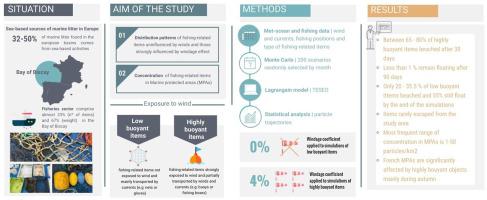当前位置:
X-MOL 学术
›
Environ. Pollut.
›
论文详情
Our official English website, www.x-mol.net, welcomes your
feedback! (Note: you will need to create a separate account there.)
Modelling the distribution of fishing-related floating marine litter within the Bay of Biscay and its marine protected areas
Environmental Pollution ( IF 7.6 ) Pub Date : 2021-09-22 , DOI: 10.1016/j.envpol.2021.118216 Ruiz Irene 1 , Abascal Ana J 2 , Basurko Oihane C 1 , Rubio Anna 1
Environmental Pollution ( IF 7.6 ) Pub Date : 2021-09-22 , DOI: 10.1016/j.envpol.2021.118216 Ruiz Irene 1 , Abascal Ana J 2 , Basurko Oihane C 1 , Rubio Anna 1
Affiliation

|
Sea-based sources account for 32–50 % of total marine litter found at the European basins with the fisheries sector comprising almost 65 % of litter releases. In the south-east coastal waters of the Bay of Biscay this figure approaches the contribution of just the floating marine litter fraction. This study seeks to enhance knowledge on the distribution patterns of floating marine litter generated by the fisheries sector within the Bay of Biscay and in particular on target priority Marine Protected Areas (MPAs) to reinforce marine litter prevention and mitigation policies. This objective is reached by combining the data on geographical distribution and intensity of fishing activity, long-term historical met-ocean databases, Monte Carlo simulations and Lagrangian modelling with floating marine litter source and abundance estimates for the Bay of Biscay. Results represent trajectories for two groups of fishing-related items considering their exposure to wind; they also provide their concentration within 34 MPAs. Zero windage coefficient is applied for low buoyant items not subjected to wind effect. Highly buoyant items, strongly driven by winds, are forced by currents and winds, using a windage coefficient of 4 %. Results show a high temporal variability on the distribution for both groups consistent with the met-ocean conditions in the area. Fishing-related items driven by a high windage coefficient rapidly beach, mainly in summer, and are almost non-existent on the sea surface after 90 days from releasing. This underlines the importance of windage effect on the coastal accumulation for the Bay of Biscay. Only around 20 % of particles escaped through the boundaries for both groups which gives added strength to the notion that the Bay of Biscay acts as accumulation region for marine litter. MPAs located over the French continental shelf experienced the highest concentrations (>75 particles/km) suggesting their vulnerability and need for additional protection measures.
中文翻译:

对比斯开湾及其海洋保护区内与捕捞相关的漂浮海洋垃圾的分布进行建模
海洋来源占欧洲盆地发现的海洋垃圾总量的 32-50%,其中渔业部门排放的垃圾占近 65%。在比斯开湾东南沿海水域,这一数字接近漂浮海洋垃圾部分的贡献。本研究旨在增进对比斯开湾渔业部门产生的漂浮海洋垃圾分布模式的了解,特别是对目标优先海洋保护区(MPA)的了解,以加强海洋垃圾预防和缓解政策。这一目标是通过将地理分布和捕捞活动强度的数据、长期历史气象海洋数据库、蒙特卡罗模拟和拉格朗日模型与漂浮海洋垃圾源和比斯开湾丰度估计相结合来实现的。结果代表了两组与捕鱼相关的物品考虑到风的暴露情况的轨迹;他们还提供 34 个海洋保护区内的集中服务。零风阻系数适用于不受风影响的低浮力物品。受风强烈驱动的高浮力物品受到水流和风的推动,风阻系数为 4%。结果显示,两组分布的时间变异性较高,与该地区的气象海洋条件一致。与捕鱼相关的物品在高风阻系数的驱动下迅速海滩化,主要是在夏季,并且在释放后90天后在海面上几乎不存在。这强调了风阻效应对比斯开湾沿海堆积的重要性。 只有大约 20% 的颗粒通过这两个群体的边界逃逸,这进一步证明了比斯开湾是海洋垃圾堆积区的观点。位于法国大陆架上空的海洋保护区的浓度最高(>75 颗粒/公里),表明它们的脆弱性并需要额外的保护措施。
更新日期:2021-09-22
中文翻译:

对比斯开湾及其海洋保护区内与捕捞相关的漂浮海洋垃圾的分布进行建模
海洋来源占欧洲盆地发现的海洋垃圾总量的 32-50%,其中渔业部门排放的垃圾占近 65%。在比斯开湾东南沿海水域,这一数字接近漂浮海洋垃圾部分的贡献。本研究旨在增进对比斯开湾渔业部门产生的漂浮海洋垃圾分布模式的了解,特别是对目标优先海洋保护区(MPA)的了解,以加强海洋垃圾预防和缓解政策。这一目标是通过将地理分布和捕捞活动强度的数据、长期历史气象海洋数据库、蒙特卡罗模拟和拉格朗日模型与漂浮海洋垃圾源和比斯开湾丰度估计相结合来实现的。结果代表了两组与捕鱼相关的物品考虑到风的暴露情况的轨迹;他们还提供 34 个海洋保护区内的集中服务。零风阻系数适用于不受风影响的低浮力物品。受风强烈驱动的高浮力物品受到水流和风的推动,风阻系数为 4%。结果显示,两组分布的时间变异性较高,与该地区的气象海洋条件一致。与捕鱼相关的物品在高风阻系数的驱动下迅速海滩化,主要是在夏季,并且在释放后90天后在海面上几乎不存在。这强调了风阻效应对比斯开湾沿海堆积的重要性。 只有大约 20% 的颗粒通过这两个群体的边界逃逸,这进一步证明了比斯开湾是海洋垃圾堆积区的观点。位于法国大陆架上空的海洋保护区的浓度最高(>75 颗粒/公里),表明它们的脆弱性并需要额外的保护措施。









































 京公网安备 11010802027423号
京公网安备 11010802027423号